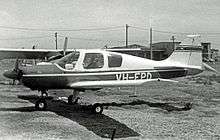Beagle Pup
The Beagle B.121 Pup is a 1960s British 2–4 seat single-engined training and touring aircraft built by Beagle Aircraft Limited at Shoreham Airport and Rearsby Aerodrome.
| B.121 Pup | |
|---|---|
 | |
| Role | General Aviation |
| Manufacturer | Beagle Aircraft Limited |
| First flight | 8 April 1967 |
| Introduction | 1968 |
| Produced | 1967–1970 |
| Number built | 176 |
| Variants | Beagle Bulldog |
Development
Beagle Aircraft Ltd chose to build the Pup following a market survey which demonstrated a global requirement for a modern, all-metal 2–4 seat training/touring aircraft to replace aging Tiger Moths and Pipers used by flying clubs.[1] American manufacturers were already fulfilling this demand with the Cessna 150 and 172 and the Piper Cherokee.

The prototype Pup (a Series 1 G-AVDF) first flew from Shoreham Airport on 8 April 1967. Soon after, more powerful Pup 150s, with seating for an extra adult, were flown in October 1967.[2] The second (G-AVLM) and third (G-AVLN) aircraft were Series 2 aircraft fitted with an enlarged rudder which became standard on all production aircraft. G-AVLM was converted during 1968 to become the series 3 prototype aircraft with a further enlarged rudder.
The first delivery (a Series 1) was to the Shoreham Flying School on 12 April 1968. The aircraft was popular and sold to flying clubs and private users worldwide. A Series 3 variant, a four-seater, was developed for the Iranian Civil Air Training Organisation. One aircraft was evaluated by the Royal New Zealand Air Force in 1969, but was not ordered. Deliveries were made to civilian operators in several countries including Australia, Sweden and Switzerland.
By 1969 production had increased at Shoreham to one Pup a day; aircraft were flown to either Rearsby Aerodrome or Cambridge Airport for painting and finishing.
In December 1969 the government withdrew financial support for Beagle and the company was placed in receivership. Over 250 Pups were on order but production ceased with the 152nd aircraft. Some remaining, nearly-completed aircraft were finished at a variety of locations, the last being G-BCGV (s/n B121-176), first registered 17 June 1974.
Design
The Pup was designed as a single-engined all-metal two-seat aerobatic aircraft or a four-seat touring aircraft. The Pup was more spacious than its direct competitors and was more of a "pilot's aeroplane"; it was a more complex design to manufacture and was also corrosion proofed throughout (usually then only an option on US-built competitors). For these reasons it was correspondingly more expensive to build, yet was sold at a competitive price. Its maintenance requires more care (i.e. expense) and its early days were troubled by issues with the doors and spares availability.
Bulldog
A military version of the Pup was developed after being assessed by Rolls Royce Test Pilot Graham Andrews, who made 12 recommendations including its adaptation to a twin seated aircraft suitable for training purposes. The aircraft evolved into the Beagle B.125 Bulldog with a 200 hp (150 kW) Lycoming engine. Only one prototype aircraft was built by Beagle (with another largely complete) before it ceased operations; the design and production was taken over by Scottish Aviation.
Variants
- Pup Series 1 (Pup 100)
- Powered by a 100 hp (75 kW) Rolls-Royce Continental O-200A engine
- Pup Series 2 (Pup 150)
- Powered by a 150 hp (110 kW) Lycoming O-320-A2B engine
- Pup Series 3 (Pup 160)
- Powered by a 160 hp (120 kW) Lycoming O-320-D2C engine
- Bulldog
- Military training version, 2 prototypes only built by Beagle
Operators
Civil operators
- Iranian Civil Air Training Organisation
- Derby Aero Club
- Shoreham Flying School
- Surrey and Kent Flying Club, Biggin Hill Aerodrome
- SkySport UK
- Netherthorpe Airfield
Specifications (Pup Series 2)
Data from Jane's All the World's Aircraft 1969–70[3]
General characteristics
- Crew: 1
- Capacity: 2 passengers
- Length: 23 ft 2 in (7.06 m)
- Wingspan: 31 ft 0 in (9.45 m)
- Height: 7 ft 6 in (2.29 m)
- Wing area: 119.5 sq ft (11.10 m2)
- Aspect ratio: 8.04:1
- Empty weight: 1,090 lb (494 kg)
- Max takeoff weight: 1,925 lb (873 kg)
- Fuel capacity: 24 imp gal (29 US gal; 110 L)
- Powerplant: 1 × Lycoming O-320-A2B air-cooled flat-four, 150 hp (110 kW)
- Propellers: 2-bladed Sensenich M.74 DMS-0-60, 6 ft 2 in (1.88 m) diameter
Performance
- Maximum speed: 138 mph (222 km/h, 120 kn)
- Cruise speed: 115 mph (185 km/h, 100 kn) (econ cruise, 55% power)
- Stall speed: 56 mph (90 km/h, 49 kn) (flaps down)
- Never exceed speed: 195 mph (314 km/h, 169 kn)
- Range: 440 mi (710 km, 380 nmi)
- Service ceiling: 14,700 ft (4,500 m)
- Rate of climb: 800 ft/min (4.1 m/s)
- Wing loading: 16.1 lb/sq ft (79 kg/m2)
- Take-off run to 50 ft (15 m): 1,480 feet (450 m)
- Landing run (from 50 ft (15 m): 1,410 ft (430 m)
References
- Carr, Richard: Pup, up and away, Article 11, pages 44–47. Design Journal, 01/11/1968 – VADS Archived 17 July 2011 at the Wayback Machine
- Frawley, Gerard (1997). The International Directory of Civil Aircraft. Australia: Aerospace Publications Pty Ltd. p. 37. ISBN 1-875671-26-9.
- Taylor 1969, pp. 193–194.
Bibliography
- Taylor, John W. R., ed. (1969). Jane's All the World's Aircraft 1969–70. London: Sampson Low Marston & Co. Ltd.
Further reading
- The Illustrated Encyclopedia of Aircraft (Part Work 1982–1985). Orbis Publishing.
- Jackson, A.J. (1974). British Civil Aircraft since 1919 Volume 1. London: Putnam. ISBN 0-370-10006-9.
External links
![]()